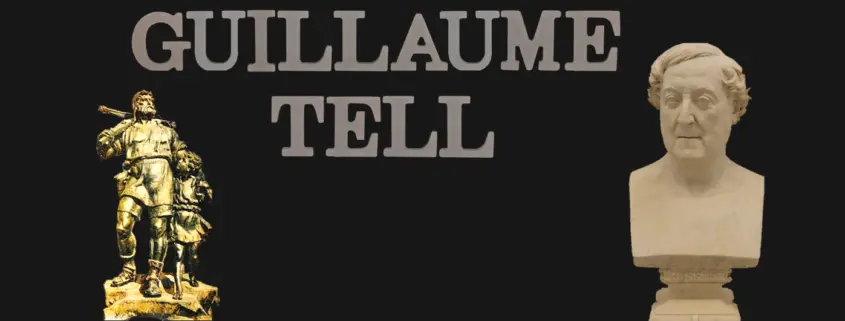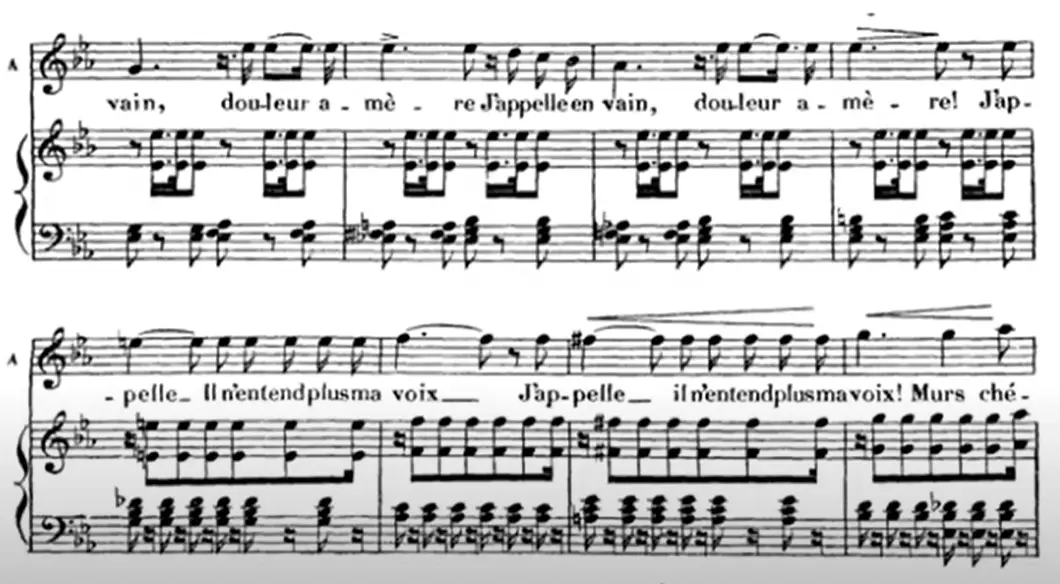ASILE HEREDITAIRE (O MUTO ASIL DEL PIANTO) – an aria from Guillaume Tell
The portrait of Gioacchino Rossini’s aria ASILE HEREDITAIRE (O MUTO ASIL DEL PIANTO)
Read Interesting facts and hear great YouTube Videos about Rossini’s famous Aria “ASILE HEREDITAIRE (O MUTO ASIL DEL PIANTO)“.
If you want to read and hear more about GUILLAUME TELL, click on this link to the opera portrait
The aria ASILE HEREDITAIRE (O MUTO ASIL DEL PIANTO) – Synopsis & Background
Synopsis: The inhabitants of the Switzerland live under the bondage of the Habsburg reeves. The Swiss Arnold is unhappily in love with the Habsburg princess Matilde. He is desperate because his compatriots despise him for it and he does not dare to propose for her. Tell tries to win him over to the Swiss cause and learns of his sincere enthusiasm, but Arnold is torn apart by his love for Matilde and the fatherland. Arnoldo secretely meets with Matilde. He is desperate, because class distinction stands between the two. Matilde can convince him that by succeeding on the battlefield of Europe he can acquire the right to marry her. When they agree to meet the following day, they hear Tell and Fuerst approaching. Matilde quickly disappears but Tell notices the shadow of the person, which arouses his suspicion. Arnold confesses his love for Matilde and tells them that he will fight for the flag of Habsburg in foreign lands. The two of them announce the terrible news that Arnold’s father had been slain by the oppressors. Arnold is destroyed and together they swear to take up the fight against the Habsburgs. Matilde and Arnold meet the next morning at a remote chapel. Arnoldo explains to her that his honour demanded that he fight for his fatherland. Horrified, Matilde learns that Gessler had Arnold’s father killed and that her dream of marrying Arnold will not come true. In the meantime, Tell has been arrested and sentenced to death because he refused to acknowledge Gessler’s rule. Arnold is in his father’s hut. He remembers him and takes leave of the place of his childhood. He is ready to die for the Swiss cause.
Arnoldo’s lyrical aria in combination with the subsequent cabaletta is one of the most difficult tenor pieces in the opera repertoire. Before we devote ourselves to the aria in detail, it is worth taking a look at the unique historical significance of this opera for the development of the tenor repertoire.
The famous “do in petto” – the birth of the heroic heroic tenor
The role of Arnold is undoubtedly one of the most difficult tenor roles in the opera repertoire. The opera-mad writer James Joyce once remarked: “I looked through the score of Guillaume Tell and I discovered that the tenor sings 456 Gs, 93 A flat, 92 As, 54 Bflats, 15 Bs, 19 Cs and two C sharps.”
The Arnold of the first performance was Adolphe Nourrit. He was the leading tenor of his time and indisputably a great singer. He had problems with this role and from the third performance onwards he is said to have omitted the aria “Asile héréditaire” (“O muto asil”) and the following Caballetta. Eight years later his rival Gilbert Duprez sang as Arnold the first documented high C from the full breast voice (“do in petto”) instead of the falsetto voice. Rossini was shocked and repulsed. He compared the tone “to the screeching of a capon whose throat is cut”.
After this event nothing was the same as before, the audience was enthusiastic and the following generation of composers turned the prevailing singing style upside down, the heroic tenor with the blaring voice was born. Even Nourrit went to Italy to learn the new style. When his wife visited him in Italy, she found that he had ruined his voice.
Rossini wrote the aria for the French Grand Opéra. The Italian version is sung just as often, so there are two linguistically different versions of this opera. For this reason you will find audio examples with two different text variations.
The aria begins with a short horn motive, which represents the memory of Arnold’s youth.
Already a few bars after the tenor’s entrance he has to sing an exposed B flat with another one two bars later.
Rossini composes the pain of farewell with a repeated increase of the phrase “J’appelle en vain”.
The aria ends with a high C.
The aria continues with the infamous caballetta “Amis, amis, secondez ma vengeance” (Corriam! Voliam! S’affretti lo scempio), which is peppered with 6 more high C’s, some of which have to be held over one and a half bars to express the ecstasy of Arnoldo.
The Aria – the text of ASILE HEREDITAIRE (O MUTO ASIL DEL PIANTO)
Asile héréditaire,
Où mes yeux s’ouvrirent au jour,
Hier encor, ton abri tutélaire
Offrait un père à mon amour.J’appelle en vain, douleur amère!..
J’appelle, il n’entend plus ma voix!
Murs chéris qu’habitait mon père,
Je viens vous voir pour la dernière fois!…
Amis, amis, secondez ma vengeance.
Si notre chef est dans les fers,
C’est à nous qu’appartient sa défense ;
D’Altdorf les chemins sont ouverts.
D’Altdorf les chemins sont ouverts.
Suivez moi ! suivez moi !
d’un monstre perfide
Trompons l’espérance homicide,
Trompons l’espérance homicide ;
Arrachons Guillaume à ses coups !
Arrachons Guillaume à ses coups !
O muto asil del pianto
Dov’io sortiva il dì:
Ieri felice… ahi, quanto!
Oggi fatal così!Invano il padre io chiamo:
Egli non m’ode più.
Fuggir quel tetto io bramo
Che caro un dì mi fu.…
Corriam, voliam, s’affretti
Lo scempio di quel vile
Che su noi trionfò.
Sì, vendetta dell’empio facciamo:
Il sentiero additarvi saprò.Ah! venite; delusa la speme
Renderem di chi vili ne brama.
Gloria, onore, vendetta ci chiama,
E Guglielmo per noi non morrà.
Ancestral home
where my eyes opened to the light of day,
beloved walls within which my father dwelt,
I come to see you for the last time!…
Friends, friends, assist my vengeance.
If our leader is in fetters
it is to us his defence belongs;
the roads to Altdorf are open,
the roads to Altdorf are open.
Follow me! Follow me!
Let us cheat the murderous hope
of a treacherous monster,
let us cheat his murderous hope;
let us wrest William from his blows!
Famous interpretations of ASILE HEREDITAIRE (O MUTO ASIL DEL PIANTO)
As already discussed, the role of Arnoldo is incredibly difficult to fill. While in the 50s and 60s two exceptional singers, Gedda and Kraus, mastered the role, it remained quiet for forty (!) years. After 2010 the picture changed again, and within a few years Juan Diego Florez, Michael Spyres, Bryn Hymel and John Ossborn made their debut in this role and mastered this murderous part brilliantly.
Gedda is said to have said that singing the Arnoldo was the biggest mistake of his career. His voice had the height and was colourful and nuanced even in the top registers.
O muto asil del pianto (1) – Gedda
In comparison, we hear Pavarotti’s interpretation. It is more dramatically drawn than Gedda’s more lyrical interpretation. The heights are a bit more forced, Pavarotti showed a big heart for taking on this role. But he deliberately refrained from singing the role on stage, because he knew that his voice would be damaged if he had to sing it in a few day intervals one after the other.
O muto asil del pianto (2) – Pavarotti
Alfredo Kraus, the phenomenal “Tenore di grazia” sings beautiful noble lines. We hear the Cavatina (from 1:30). As an encore he even sings an E flat at the end (4:48).
O muto asil del pianto (3) – Kraus
Bryn Hymel’s voice is not only powerful but also smooth. Hear an impressive long end C of the American tenor. The aria begins from 3.10.
Asile héréditaire (4) – Hymel
The next recording dates from 1904 and was sung by Francesco Tamagno, the Othello of the premiere, whom Verdi had personally chosen for this demanding role. In his Interpretation, Toscanini criticised its peculiarities, but in the Cabballetta he heard “the choir of silver trumpets” and the high C literally struck him dead.
Kesting (“The Great Singers”): “In the stretta, probably transposed by a half-tone, the tenor sings the delicate G’s and A’s immediately above the change of register with indescribable richness and intensity, and his top notes, effortlessly held, defy description.
O muto asil del pianto (5) – Tamagno
Finally, we hear an ecstatic version of the American tenor Michael Spyre, whose voice sings the high C’s brilliantly, seemingly without tiring, and yet has the souplesse in the vibrato of the first lyrical part.
Asile héréditaire (6) – Spyres
The voice of the American tenor Osborn is more lyrical than that of his compatriot Spyres and is distinguished by its strong vibrato.
Asile héréditaire (7) – Osborn
Peter Lutz, opera-inside, the online opera guide to the aria “ASILE HEREDITAIRE (O MUTO ASIL DEL PIANTO)” from the opera “Guillaume Tell” from Gioacchino Rossini.








I like Bryn Hymels Version. I saw him in Munich. It was fantastic